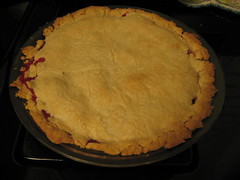Translating French into English
August 22nd, 2009 at 7:44 pm (French)
… using your own skills, not babelfish or Google translate, that is.
Fall is coming, and everyone’s going back to school. While browsing a bulletin board at the local movie theater, an ad for a class on French translation caught my eye. I realized that it had been over a year since my last course (Geology 601, Seminar in Sedimentary Geology), and really, that’s just too long a gap. Plus, French! Examining my weekly commitments, I decided that I had room to take on another one.
One reason I haven’t taken more language classes in recent years is that, lacking some real-world setting in which I would need to use those skills, I know whatever I’d learn would fade gradually after the class ended. But it occurred to me that this could be different. Polishing up reading and translation skills would mean that I could return to my French copy of “Fellowship of the Ring” or “Alice in Wonderland” or “The Little Prince” (or several others I have). I could browse French websites and news articles. It’s a skill I could more realistically have a chance to retain. And I was curious: how would a course teach you to translate, in a way different from a regular language class that teaches you more vocabulary and grammar? Why the specialization?
So I applied to the local community college and was accepted just six hours later. The textbook is a photocopied version of French for Reading Knowledge. It seems that a focus on reading can indeed be a bit different from a regular language class; I think it may be optimized for you to simply acquire a mapping of French constructions into English ones. The result almost certainly is not true fluency, since you need not generate your own constructions or worry about pronunciation or anything like that. This seems a little like cheating, except that the reading skill alone can have real value. Some people take this sort of class to be able to read technical articles related to their research that have not yet been translated. And as above, it’s the skill you could most likely keep practiced even if you don’t live in a French-speaking country.
Classes with similar titles are offered at other schools. The “French for Reading Knowledge” course at UW Madison fulfills a graduate student foreign language requirement. At the conclusion of the class, you must take a one-hour translation test. Want to try your own hand? Here’s a PDF version of their Fall 2008 exam, which is a five-paragraph bit about Vladimir Nabokov. You’re permitted a French-English dictionary.
I’m eager to see how this class works out. Will we be assigned specific texts, or will we be encouraged to choose our own? I’m envisioning some interesting discussions about literal translations versus those that deviate from the actual words but capture more of the sense, style, or feel of a passage. Will we talk about translating poems and songs, which are extra-challenging due to both a need for non-literalism and a desire to preserve rhyme and meter? Class doesn’t start until September 3, and I already have a host of questions to ask!

